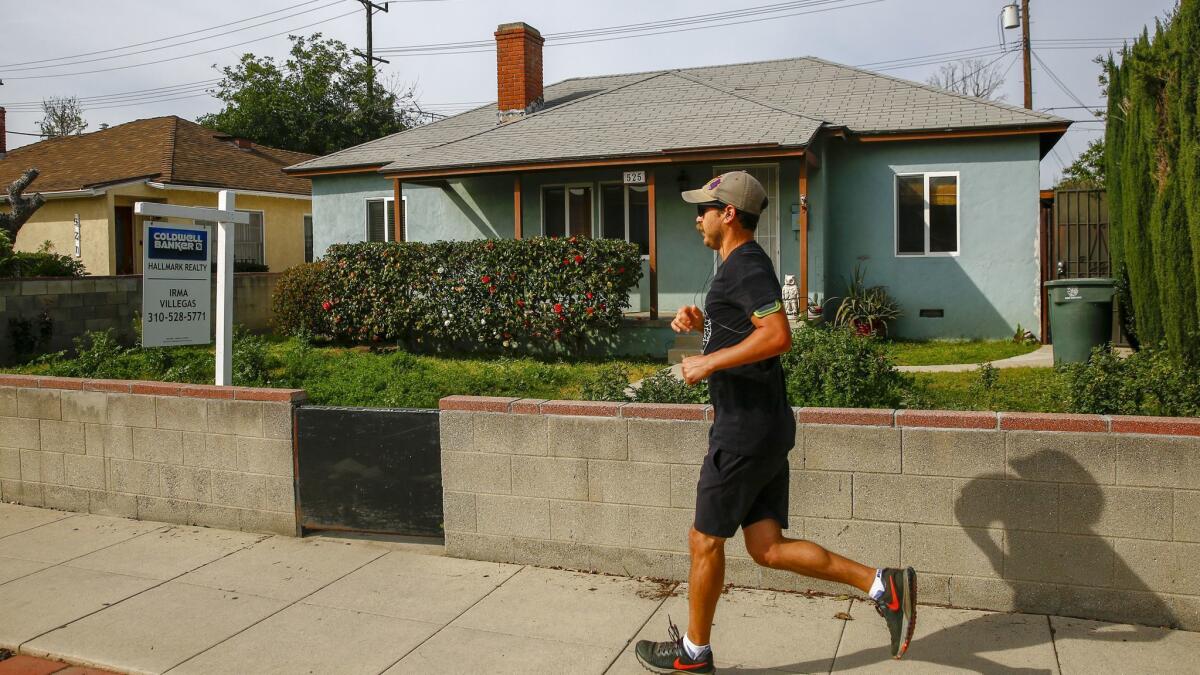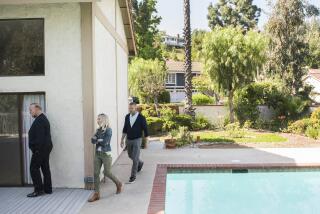There’s a pandemic, but Southern California home prices are at record levels

In the middle of a global pandemic, Southern California home prices keep setting records.
The six-county region’s median price reached $600,000 in August, up 12.1% from a year earlier, according to data released Wednesday by DQNews.
That was the largest percentage increase since 2014 and the third consecutive month during which prices set a new all-time high. Sales rose 2.4% from a year earlier.
“We have had houses with 40 to 50 offers,” said Syd Leibovitch, president of Rodeo Realty, which has offices throughout the Los Angeles area. “It’s just bizarre.”
Although the price leaps may seem unlikely amid double-digit unemployment, analysts say the trend reflects the uneven effect of the coronavirus and its economic fallout.
Compared with low-wage workers, people who tend to have the financial ability to buy homes have been far less likely to lose their jobs, and in some ways, their ability to purchase a house has only expanded.
Interest rates have plunged, with the average rate on a 30-year fixed-rate mortgage now below 3%. And many typical entertainment and recreational activities are still closed or operating at reduced capacity, leading some households to save more at the very time they realize they could use much more space.
“Where are you going to take your Zoom calls where you don’t interfere with one another?” said Kevin Tidwell, an agent with Rodeo Realty.
Tidwell said the desire for larger homes with bigger backyards is causing people to increasingly come to the San Fernando Valley from central L.A and for those already in the Valley to trade up in size.
Mortgage rates are at historic lows, so there’s money to be saved there by buying a home now. But when it comes to the home’s sales price, don’t expect a discount because of the economic downturn.
The desire for more space, coupled with historically low borrowing costs, has helped boost sales and prices across the country. But part of the sharp double-digit increase in the median is simply its definition.
The median is the point at which half the homes sold for more and half for less and thus reflects not only actual increases in value but also the types of homes selling at any given moment.
Jordan Levine, deputy chief economist at the California Assn. of Realtors, said a desire for larger homes could, in and of itself, push up the median. But more important is the uneven effects of the economic downturn.
Though many low-wage workers probably couldn’t have bought a home before the crisis, Levine said the country’s economic pain has been felt on a sliding scale, with middle-income households hit less than low-income households, but harder than the wealthy, factors that are causing a shift toward the luxury segment of the market.
For example, homes that sold for $1 million or more accounted for 22% of all homes sold in California last month, up from 16% in August 2019, the trade group’s data show. The share of homes that sold for less than $500,000 fell to 38% of all sales in August, down from 46% a year earlier.
“People who are shopping down at the bottom end of the market are more likely to have suffered job loss or had a family member lose income that precludes buying a home,” he said. “It’s hard for me to break down what percent of that double-digit price growth [in the median] is due to the change in the mix, but part of it is definitely that.
“That being said, we are also seeing real honest-to-goodness price growth.”
Real estate agents say they see it in the increasing number of bidding wars on individual homes, as more people enter the market but find few options available.
Economists say too little home building is a driving factor behind California’s long-running inventory shortages.
Selma Hepp, deputy chief economist at CoreLogic, said the coronavirus is making the problem worse: Millennials are increasingly entering their prime home-buying years, but baby boomers who own large swaths of the housing stock are at heightened risk for complications from COVID-19.
“They don’t want to be moving right now,” she said of the older generation.
In Los Angeles and Orange counties, there were 19% fewer homes for sale in August than a year earlier, according to Zillow. Larger declines were seen in the Inland Empire, as well as in San Diego and Ventura counties.
“We have no inventory,” said Heidi Ludwig, a Redfin real estate agent who specializes in the South Bay.
How long the upswing will continue is unclear. Part of the increase in sales and prices reflects pent-up demand from the spring, when stay-at-home orders and fears of the virus all but froze the market during what is typically its busiest season.
If the economy takes a turn for the worse, the housing market could also trend downward.
For now, prices are shooting up across the region.
- In Los Angeles County, the median home price rose 12.2% from a year earlier to $692,750 in August, while sales fell 3.8% from a year earlier.
- In Orange County, the median home price rose 11.6% to $800,000, while sales climbed 10.9%.
- In Riverside County, the median home price rose 13.1% to $441,000, while sales edged up 0.6%.
- In San Bernardino County, the median home price rose 9.8% to $380,000, while sales climbed 2.8%.
- In San Diego County, the median home price rose 9.4% to $640,000, while sales climbed 7.2%.
- In Ventura County, the median home price rose 8.1% to $647,250, while sales climbed 7%.
Antonio Herrera, 28, is among those trying to break into homeownership. He and his partner are looking for homes in the $500,000 range in South Los Angeles but so far have had trouble closing a deal.
“I expected homes to maybe sell slightly over [asking],” he said, “but we are seeing houses go up $50,000 to $100,000.”
More to Read
Sign up for Essential California
The most important California stories and recommendations in your inbox every morning.
You may occasionally receive promotional content from the Los Angeles Times.







